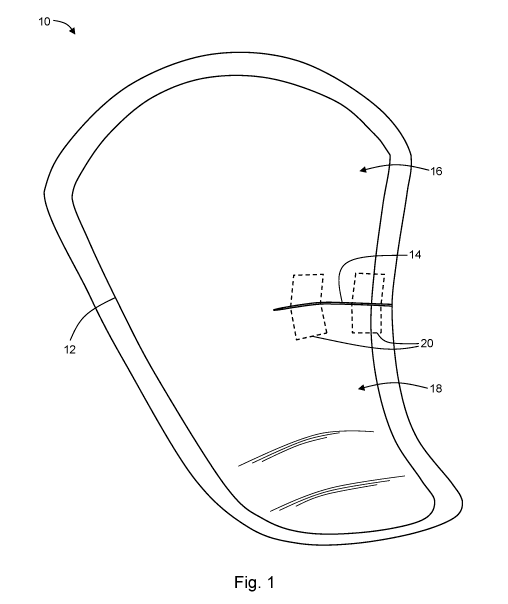Une partie des informations de ce site Web a été fournie par des sources externes. Le gouvernement du Canada n'assume aucune responsabilité concernant la précision, l'actualité ou la fiabilité des informations fournies par les sources externes. Les utilisateurs qui désirent employer cette information devraient consulter directement la source des informations. Le contenu fourni par les sources externes n'est pas assujetti aux exigences sur les langues officielles, la protection des renseignements personnels et l'accessibilité.
L'apparition de différences dans le texte et l'image des Revendications et de l'Abrégé dépend du moment auquel le document est publié. Les textes des Revendications et de l'Abrégé sont affichés :
| (12) Demande de brevet: | (11) CA 3080344 |
|---|---|
| (54) Titre français: | DISPOSITIF POUR L'INCONTINENCE |
| (54) Titre anglais: | INCONTINENCE DEVICE |
| Statut: | Examen demandé |
| (51) Classification internationale des brevets (CIB): |
|
|---|---|
| (72) Inventeurs : |
|
| (73) Titulaires : |
|
| (71) Demandeurs : |
|
| (74) Agent: | MACRAE & CO. |
| (74) Co-agent: | |
| (45) Délivré: | |
| (86) Date de dépôt PCT: | 2018-10-26 |
| (87) Mise à la disponibilité du public: | 2019-05-02 |
| Requête d'examen: | 2023-10-16 |
| Licence disponible: | S.O. |
| (25) Langue des documents déposés: | Anglais |
| Traité de coopération en matière de brevets (PCT): | Oui |
|---|---|
| (86) Numéro de la demande PCT: | PCT/US2018/057871 |
| (87) Numéro de publication internationale PCT: | WO2019/084511 |
| (85) Entrée nationale: | 2020-04-24 |
| (30) Données de priorité de la demande: | ||||||
|---|---|---|---|---|---|---|
|
La présente invention peut être réalisée sous la forme d'un dispositif pour l'incontinence destiné à un individu portant un cathéter. Le dispositif comprend un tampon absorbant conçu pour être porté par l'individu. Le tampon absorbant comporte une fente séparant partiellement le tampon en deux parties. Un élément de fixation peut être utilisé pour fixer de manière sélective les deux parties l'une à l'autre. De cette manière, un cathéter peut être disposé à travers la fente du dispositif et les deux parties peuvent être attachées l'une à l'autre à l'aide de l'élément de fixation pour entourer une circonférence du cathéter. L'élément de fixation peut être réutilisable. Dans certains modes de réalisation, le dispositif comprend plus d'un élément de fixation. L'élément de fixation peut être un ou plusieurs éléments parmi un adhésif, un élément de fixation à boucles et crochets, un élément de fixation à encliquetage, ou des combinaisons de ceux-ci.
The present disclosure may be embodied as an incontinence device for a catheterized individual. The device includes an absorbent pad configured to be worn by the individual. The absorbent pad having a slit partially separating the pad into two portions. A fastener may be provided for selectively attaching the two portions to each other. In this way, a catheter may be disposed through the slit of the device and the two portions may be attached to each other using the fastener to surround a circumference of the catheter. The fastener may be reusable. In some embodiments, the device includes more than one fastener. The fastener may be one or more of an adhesive, a hook-and-loop fastener, a snap fastener, or combinations thereof.
Note : Les revendications sont présentées dans la langue officielle dans laquelle elles ont été soumises.
Note : Les descriptions sont présentées dans la langue officielle dans laquelle elles ont été soumises.

Pour une meilleure compréhension de l'état de la demande ou brevet qui figure sur cette page, la rubrique Mise en garde , et les descriptions de Brevet , États administratifs , Taxes périodiques et Historique des paiements devraient être consultées.
| Titre | Date |
|---|---|
| Date de délivrance prévu | Non disponible |
| (86) Date de dépôt PCT | 2018-10-26 |
| (87) Date de publication PCT | 2019-05-02 |
| (85) Entrée nationale | 2020-04-24 |
| Requête d'examen | 2023-10-16 |
Il n'y a pas d'historique d'abandonnement
Dernier paiement au montant de 210,51 $ a été reçu le 2023-10-16
Montants des taxes pour le maintien en état à venir
| Description | Date | Montant |
|---|---|---|
| Prochain paiement si taxe applicable aux petites entités | 2024-10-28 | 100,00 $ |
| Prochain paiement si taxe générale | 2024-10-28 | 277,00 $ |
Avis : Si le paiement en totalité n'a pas été reçu au plus tard à la date indiquée, une taxe supplémentaire peut être imposée, soit une des taxes suivantes :
Les taxes sur les brevets sont ajustées au 1er janvier de chaque année. Les montants ci-dessus sont les montants actuels s'ils sont reçus au plus tard le 31 décembre de l'année en cours.
Veuillez vous référer à la page web des
taxes sur les brevets
de l'OPIC pour voir tous les montants actuels des taxes.
| Type de taxes | Anniversaire | Échéance | Montant payé | Date payée |
|---|---|---|---|---|
| Le dépôt d'une demande de brevet | 2020-04-24 | 400,00 $ | 2020-04-24 | |
| Taxe de maintien en état - Demande - nouvelle loi | 2 | 2020-10-26 | 100,00 $ | 2020-09-21 |
| Taxe de maintien en état - Demande - nouvelle loi | 3 | 2021-10-26 | 100,00 $ | 2021-09-20 |
| Taxe de maintien en état - Demande - nouvelle loi | 4 | 2022-10-26 | 100,00 $ | 2022-10-26 |
| Taxe de maintien en état - Demande - nouvelle loi | 5 | 2023-10-26 | 210,51 $ | 2023-10-16 |
| Requête d'examen | 2023-10-26 | 816,00 $ | 2023-10-16 |
Les titulaires actuels et antérieures au dossier sont affichés en ordre alphabétique.
| Titulaires actuels au dossier |
|---|
| HEALTH RESEARCH, INC. |
| Titulaires antérieures au dossier |
|---|
| S.O. |